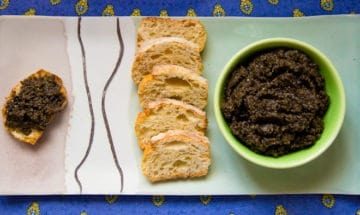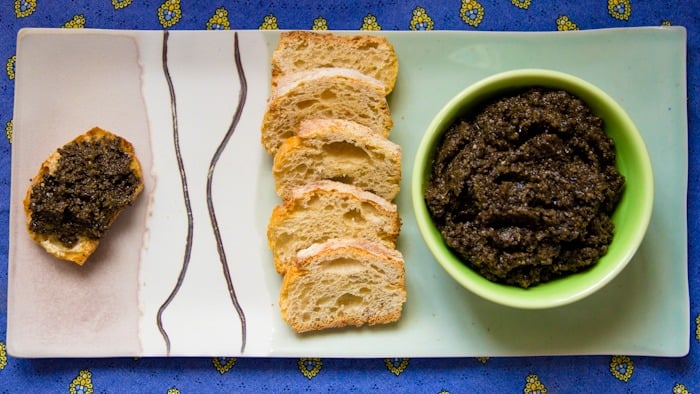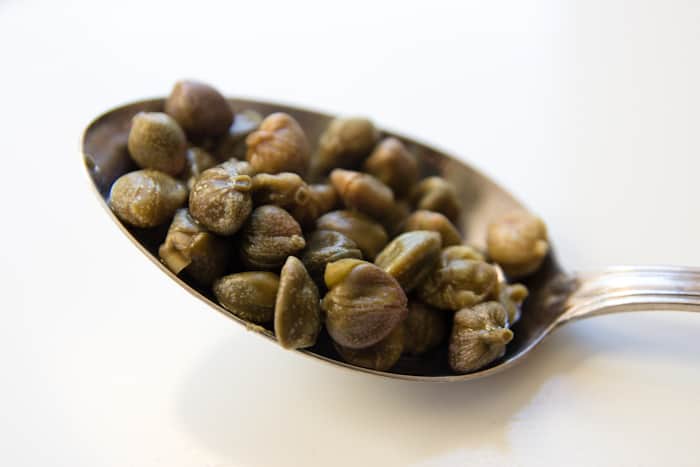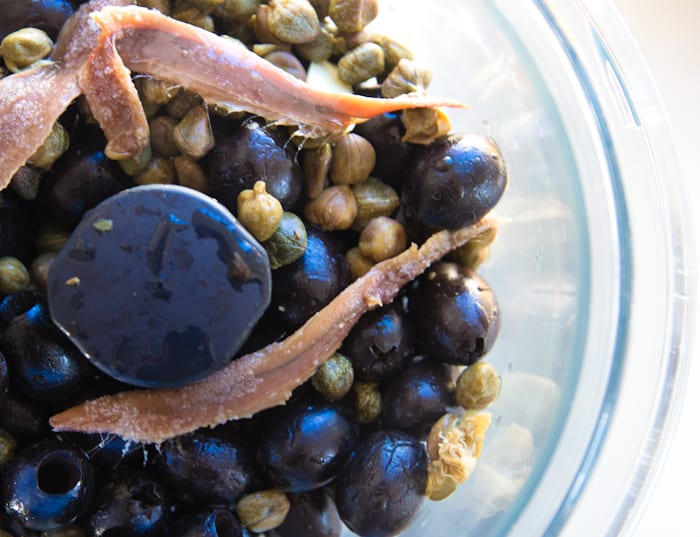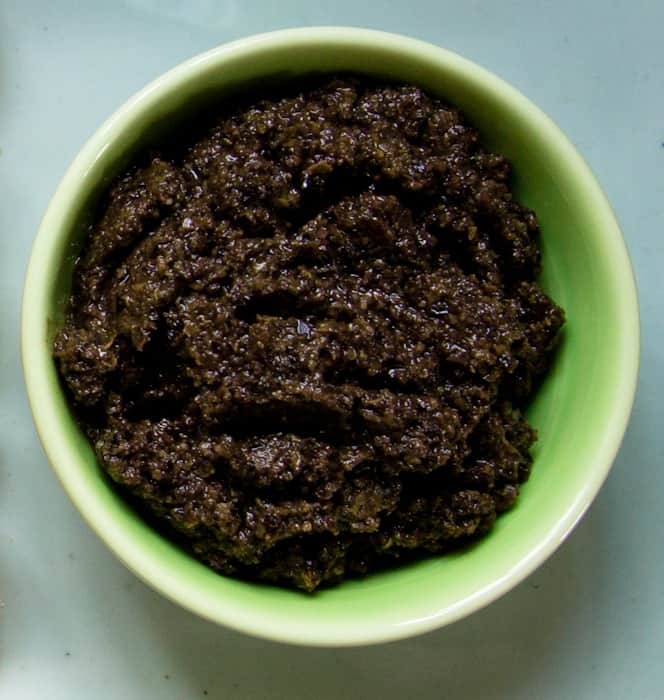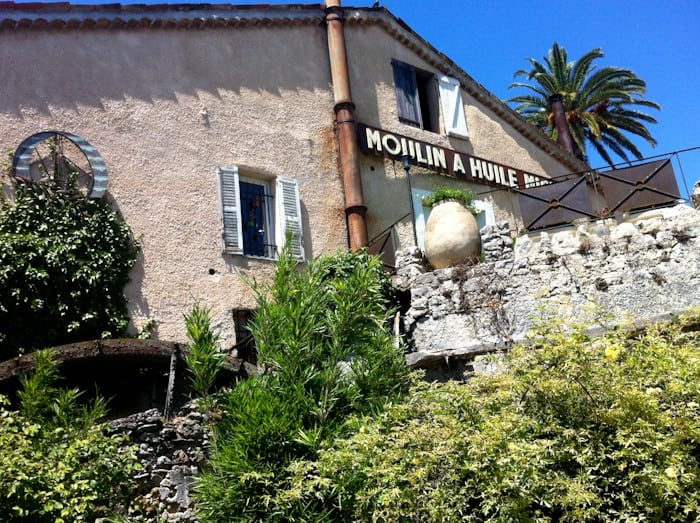It’s the season for tree-beating
Over the last month, in the fields all over Southern Italy, and on the Cote d’Azur in France, people have been whacking trees with sticks. This may seem like strange, and relatively cruel treatment for some poor trees who did nothing but stand there and help to prevent the warming climate from speeding along like an out-of-control freight train, but such is the life of an olive tree full of shining black olives in the Fall months. Nets are rolled out below the trees and then long sticks are used to knock the olives into the nets, so it’s easier to gather them into buckets. They are then either taken to the mill to be turned into olive oil, or cured so they they can be made into delicious spreads, such as this tapenade (olive pâté) that graces every self-respecting aperitif table in the South-East of France during the warmer months.
The few ingredients that make up tapenade
Tapenade is made with very few ingredients, which means that the olives have to be of excellent quality for it to taste good. The other two main ingredients are capers and anchovies. If you have an aversion to anchovies like I do, never fear, as you really can’t taste them (and that’s coming from someone who can taste an anchovy if it passed within an arm-length of a pizza). The capers in the photo above are some I smuggled back on my last trip to Sicily a few weeks ago. There’ll be more on that coming up in the near future, but for now, I’ll just say that these capers are the plumpest ones I’ve ever come across! They are grown on a volcanic island that lies between Sicily and Tunisia called Pantelleria. When we were taking the plane from Trapani to head back home, I was really tempted to jump on a flight I saw that was about to leave for the island! Unfortunately, real life kicked in. I guess the kids did have to go back to school……plus, we didn’t have enough underwear for those extra days. Always an important thing to take into account.
All about tapenade
The more traditional tapenade is made with black olives, but I have often seen green olive tapenade in the shops and on the market stalls here in Southern France. I have to confess that this was the first time I’ve ever made tapenade as it’s SO widely available here that even the small effort of making it at home is hardly worth it! In the supermarket alone, there is a whole shelf taken up with different kinds of tapenade and at the Friday market in the village, there are stalls which sell nothing but olives, olive oil and tapenade! For those of you who don’t live near an olive grove, it IS worth making. Serve it up with some slices of good bread, along with the bowl of pistachios or crisps next time you have someone over for a drink, and they love you for it!
The recipe for tapenade has to be one of the shortest I’ve ever written. If you use olives without stones in them, it will take you more time to get the ingredients out of the fridge than to make the actual pâté!
Travel Photo Of The Week
If you’re ever on the Cote d’Azur and want to check out a real working olive mill, and maybe buy some delicious olive oil products, this olive oil mill in Opio (25 minutes from Cannes) is a great place to go. We have a few small olive trees in our garden. I’m waiting impatiently for them to grow bigger so that I can pick their olives and take them to the mill. When you have at least 5 kg (11 lbs) of olives, they will press them for you and you get to have your own little bottle of home-grown olive oil. How exciting is that!
This post is part of the monthly link up for Cucina Conversations. This month we’re celebrating olive oil, Italy’s liquid gold. I have added a recipe to the group link-up that is actually french in origin, since the part of France I live in did belong to the Savoy Kingdom a few hundred years ago until the King Emanuel II gave it to Napoleon III as part of an agreement that started the unification of what we know today as the country of Italy. The traditions and culture around the olive and in the making of olive oil have continued from before that time, and are still very similar to those in Southern Italy today. The only thing that changed is that you have to go across the border into Italy to get good coffee, but that’s another story!
You can read all about other delicious recipes centred around olives and olive oil below from:
Francesca of Pancakes And Biscotti with Cicoria ripassata alla Romana (Cooked Dandelion Greens, Roman-Style)
Carmen of The Heirloom Chronicles with Melanzane Sott’Olio (Eggplant Preserved In Olive Oil)
MariaLuisa of Marmellata Di Cipolle with Bruschetta With Roasted Peppers
Daniela of Le Dani Gourmet with Farinata di Cavolo Nero (Polenta with Tuscan Kale)
Flavia of Flavia’s Flavours with Cannellini All’Olio
and Rosemarie from Turin Mamma with a traditional recipe from Piemonte called Bagna Cauda.
By Lisa Watson
Black olive tapenade
Ingredients
- 200 g pitted Black Olives 1 1/2 cups
- 1 Garlic Clove
- 40 g Capers 2 Tbsp
- 3 Anchovies
- 5 Tbsp Olive Oil
- 1 Tbsp Lemon Juice optional
Instructions
- Place all the ingredients in a blender and blend them until you have a smooth mixture.
- Serve as an aperitif with crusty bread or bread-sticks.
- Tapenade will keep for up to 5 days in the fridge.
